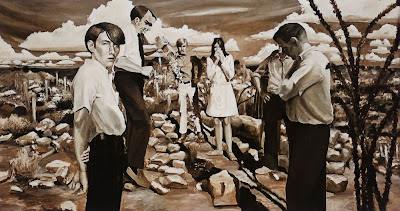The Italian Pavilion at the Venice Biennale
31 August 2007
The Fence 4 (chicken wire) 2006-7
Oil on Canvas 71 x 71 cm
Frankly I was very disappointed with most of the painting on show this year in the Italian Pavilion. However, I did find the group of five paintings by Susan Rothenberg interesting, representing a major shift in direction since I had last seen her work.
After making her name with iconic paintings of horses in the 1970’s and 80’s she moved to New Mexico and broadened her subject matter to encompass the landscape around her and her working environment. Part of this transition has been the gradual appearance of figures within the paintings and the introduction of narrative. This grouping of five paintings could almost be telling the story of erecting a fence on the ranch she shares with husband Bruce Nauman.

The painting I have chosen is the smallest of the group and the only one without coloured elements. Taken in isolation it acquires a totally different mood to the rural scenes depicted in the others with their horses and dogs cavorting about as the male figure sets about repairing the fence. True the subject could be repairing the fence, but the framing of the action results in ambiguity and instead of the face showing despair about the task in hand, the emotion can be read as trapped resignation. One can only guess at the intention of the artist but the image certainly encourages a melancholic reading.
Susan Rothenberg The Fence 2 (Holding), 2007 oil on canvas 167 x 225 cmThis melancholic aura is accentuated both by the muted palette and her loose gestural brushwork. She doesn’t paint from life, nor does she work from sketches, instead painting directly onto the canvas with dilute paint. She then starts building up the surface, making corrections and alterations, and leaving some of the original drawing showing[1]. Although this painting is perhaps not a good example of that incremental process of statement, revision, cancellation, and restatement, I think it is in evidence and also reinforces the latent sadness in the image.

This painting from the series (The Fence 2 Holding, 2007) shows her technique more clearly, but the mood for me is one of puzzlement rather than melancholic.
[1] Wright, Karen, Interview with Susan Rothenberg, Modern Painter Autumn 2003 p60
©blackdog 2009














 Four of her works were exhibited as part of the excellent “The Painting of Modern Life” show at the Hayward Gallery. This was my first opportunity to see her work first hand. She works from film stills taken from the paused video or DVD of a film using this as the starting point for her paintings.
Four of her works were exhibited as part of the excellent “The Painting of Modern Life” show at the Hayward Gallery. This was my first opportunity to see her work first hand. She works from film stills taken from the paused video or DVD of a film using this as the starting point for her paintings.


